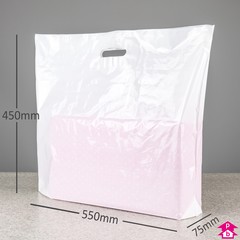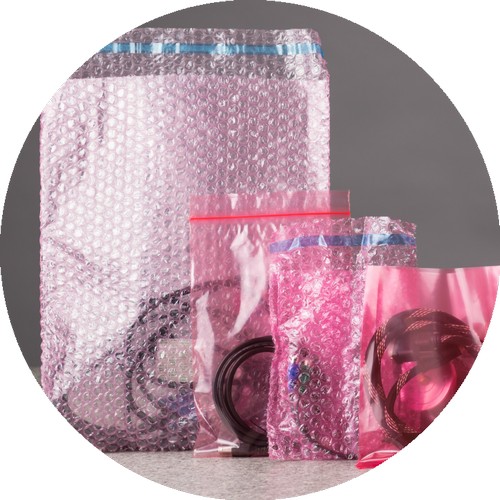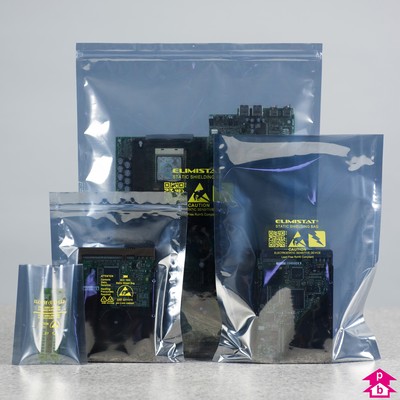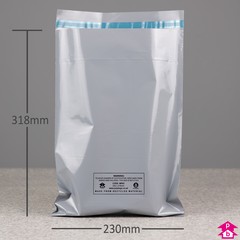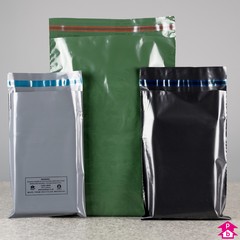550mm wide x 450mm high x 35 micron thickness, 75mm bottom gusset
From £44.87 per 500
- 100% recycled
- Biodegradable
- Carbon neutral
- Compostable
- Recyclable
- Renewable
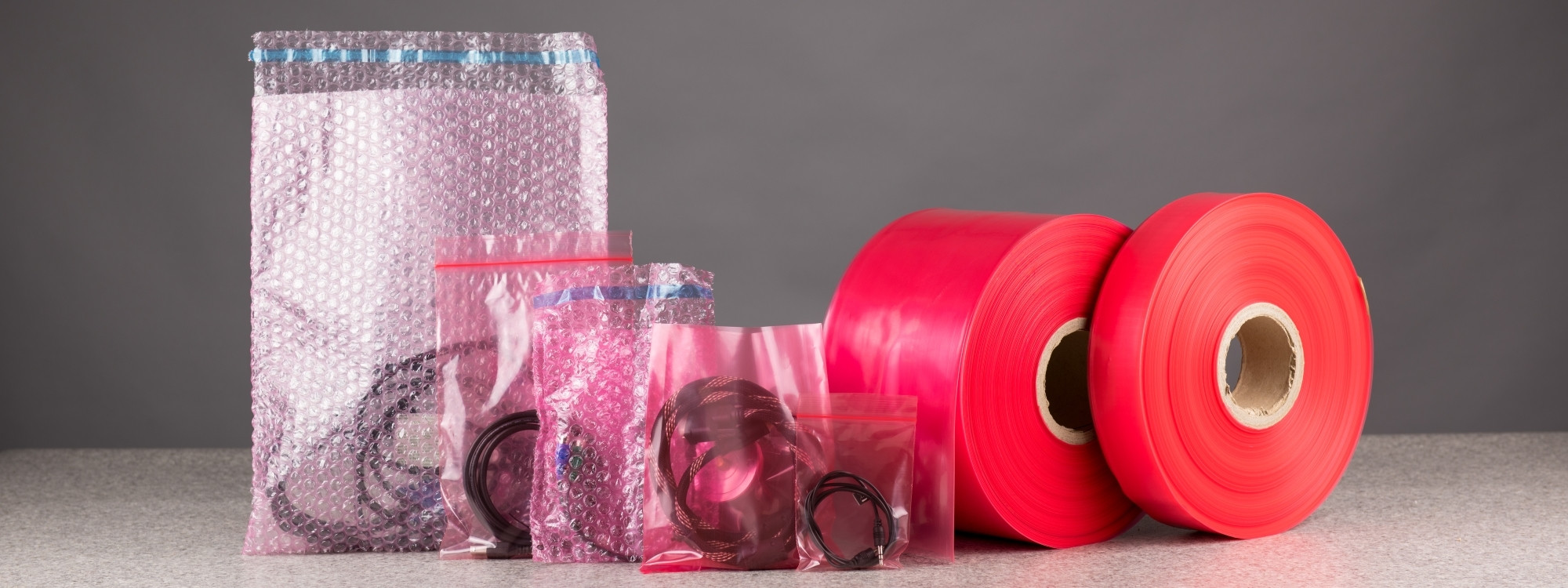
Antistatic bags & film
 Antistatic bags and film prevent the build-up of static electricity on their surface, thanks to a dissipative coating on the distinctive pink polythene.
Antistatic bags and film prevent the build-up of static electricity on their surface, thanks to a dissipative coating on the distinctive pink polythene.
They are used primarily for the storage and transportation of components used in the manufacture of electrical items, to help prevent delicate electronics being damaged by a static charge.
Antistatic bags and film are safe to use in an electrostatic protected area (EPA) or static-free workstation but they are not resistant to electrostatic discharge (ESD) in the same way as silver static-shielding bags.
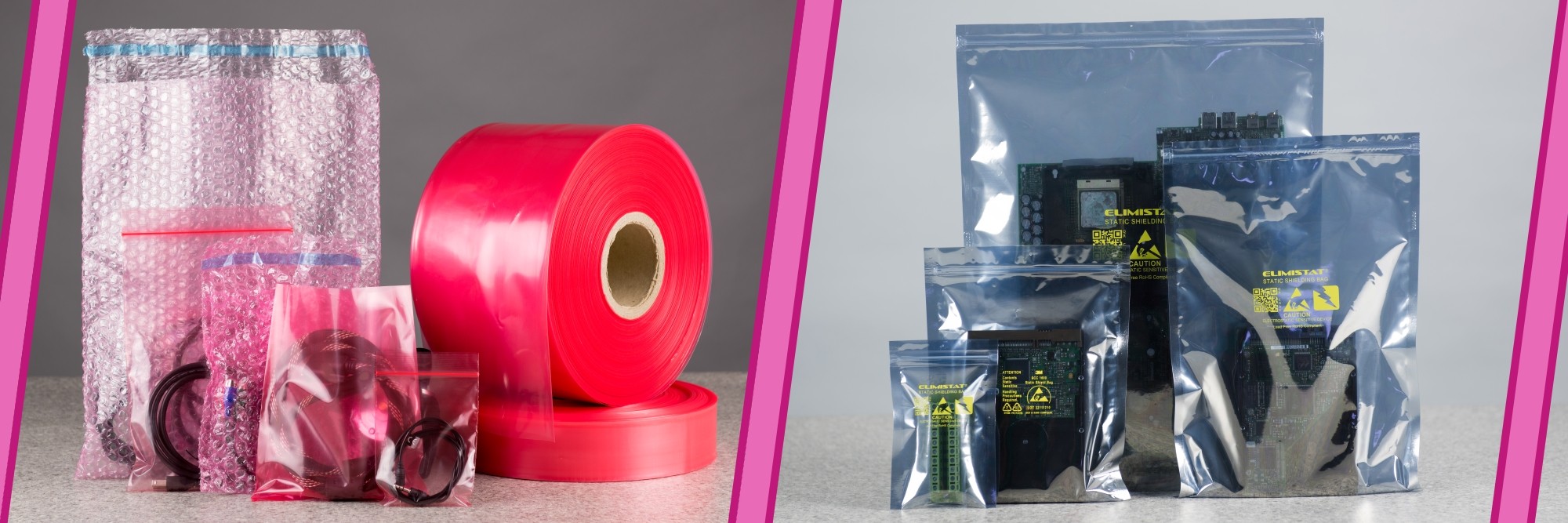
Antistatic bags or ESD bags?
There are two main types of antistatic bags: pink dissipative antistatic bags and silver electrostatic discharge (ESD) shielding bags.
Whilst both prevent the build-up of static electricity, they offer different levels of protection to the bag’s contents so it is important to choose the right bag for the items that you are handling:
- Use electrostatic discharge (ESD) bags to wrap static-sensitive electronics, such as computer hard drives, motherboards, graphics cards etc.
- Use pink antistatic bags or film for items that are not susceptible to ESD damage themselves but may carry an electrical charge (e.g. nuts, bolts, cables) to help prevent damage to any static-sensitive parts they come into contact with.
Both types of bags are suitable for introduction to an electrostatic protected area (EPA) - a crucial workspace used in the manufacture, servicing or repair of electronic items.
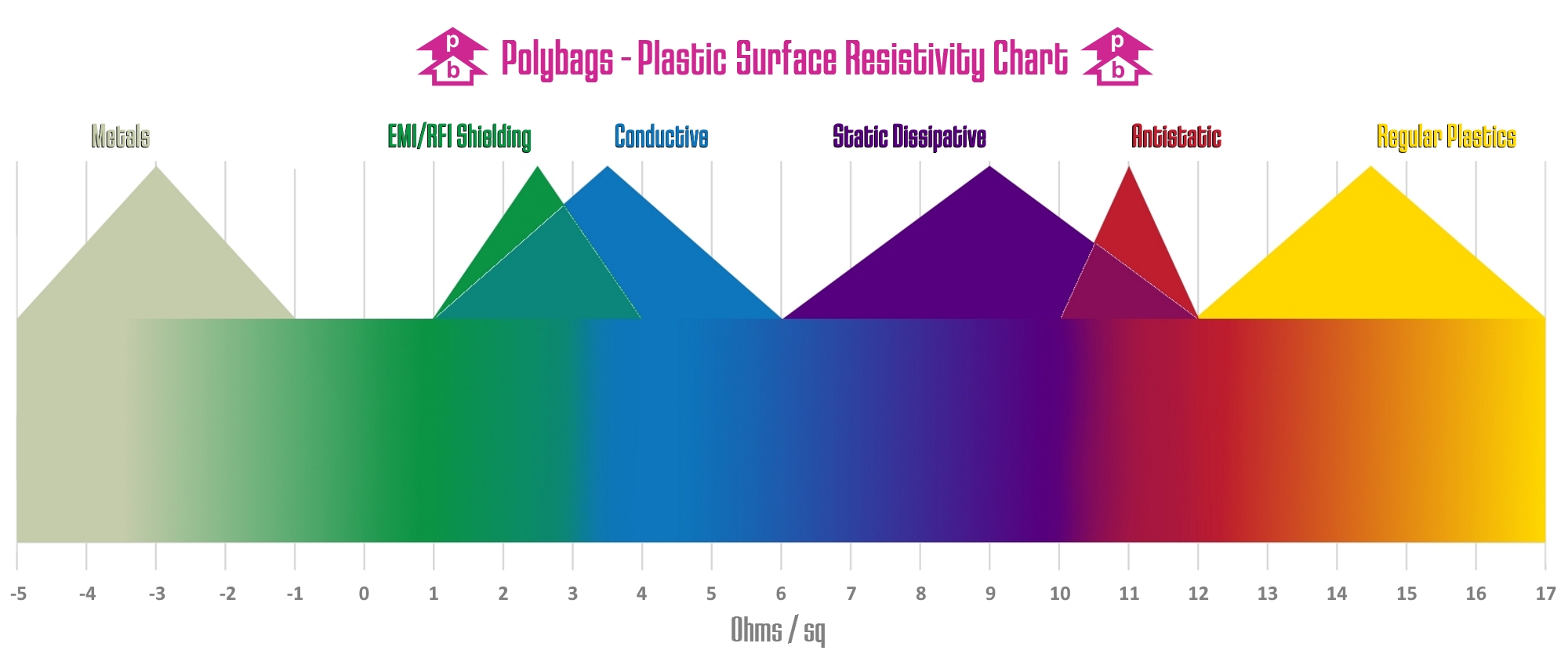
Pink antistatic polythene and silver static-shield (ESD) polythene have different levels of surface resistivity so they handle static electricity in different ways.
Pink antistatic bags & film
Pink antistatic bags are made from type II industry-standard pink polythene film, which contains an antistatic additive, introduced during the manufacturing process. This additive reduces the surface resistivity of polythene from over 1012 ohms/square to between 1010 and 1012 ohms/sq - i.e. it allows an electrical charge to pass more easily across its surface.
Whereas ordinary plastics (>1012 ohms/sq) act as insulators, thereby holding an electrical charge (static electricity) when rubbed against another item (tribocharging), pink antistatic polythene inhibits tribocharging, thanks to a dissipative coating that transfers the electrical charge to ground, or whatever the bag or film is touching.

Available in the form of plain bags, grip seal bags, bubble bags or layflat tubing (see below), this distinctive pink packaging is suitable for introduction to an electrostatic protected area.
However, although in the antistatic range - as it inhibits the build-up of static electricity on its surface - pink antistatic polythene does not protect items from an electrostatic discharge (ESD) that may be transferred from another source (e.g. a person).
Pink antistatic layflat tubing
Polybags also manufactures a wide range of pink antistatic layflat tubing which provides the same benefits of antistatic bags, but provides more flexibility for the customer.
Available in huge range of sizes - from 2" to 48" wide - this versatile film is easily customised to meet your own specifications, making it easier to package items of unusual shapes and sizes.
Just dispense as much antistatic film off the roll as you require, then cut and seal with one of our heat sealers to make your very own antistatic bags to just the size you need.
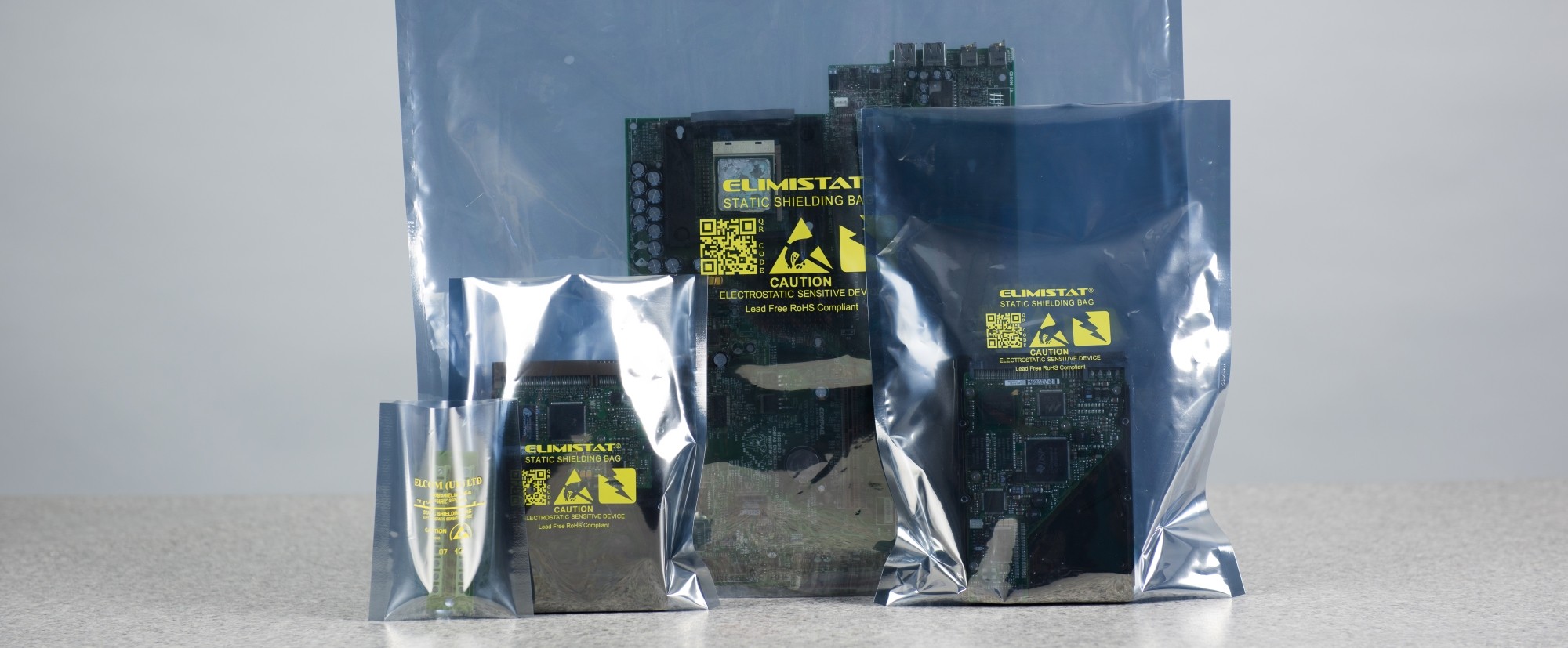
Static shielding bags (or ESD bags)
Static shield bags or electrostatic discharge (ESD) bags, are silver multi-layered bags featuring a layer of conductive metallised polyester between an internal layer of polythene and an external antistatic and abrasion-resistant lacquer.
Any materials with a surface resistance of between 106 and 1012 ohms/square are considered static-dissipative materials and generally allow for the dissipation of electrical charges within milliseconds.
Polybags' ESD bags have a surface resistance of 108 to 1011 ohms/sq and so are further into the static dissipative range than pink antistatic bags, meaning they are more adept at dissipating electrical charges.
ESD shielding bags not only prevent the build-up of static electricity (tribocharging) when they are rubbed against another material but, as the name suggests, they also protect the contents of the bag from electrostatic discharge (ESD) transferred from an external source.
So if something or someone that is holding a charge comes into contact with an ESD bag, the bag's metal layer shields the contents from that charge via the Faraday cage effect, which distributes the charge across the bag and keeps it away from the bag interior.
ESD bags are the preferred choice of antistatic bag for handling delicate electronic items and sensitive parts that may be susceptible to static damage.
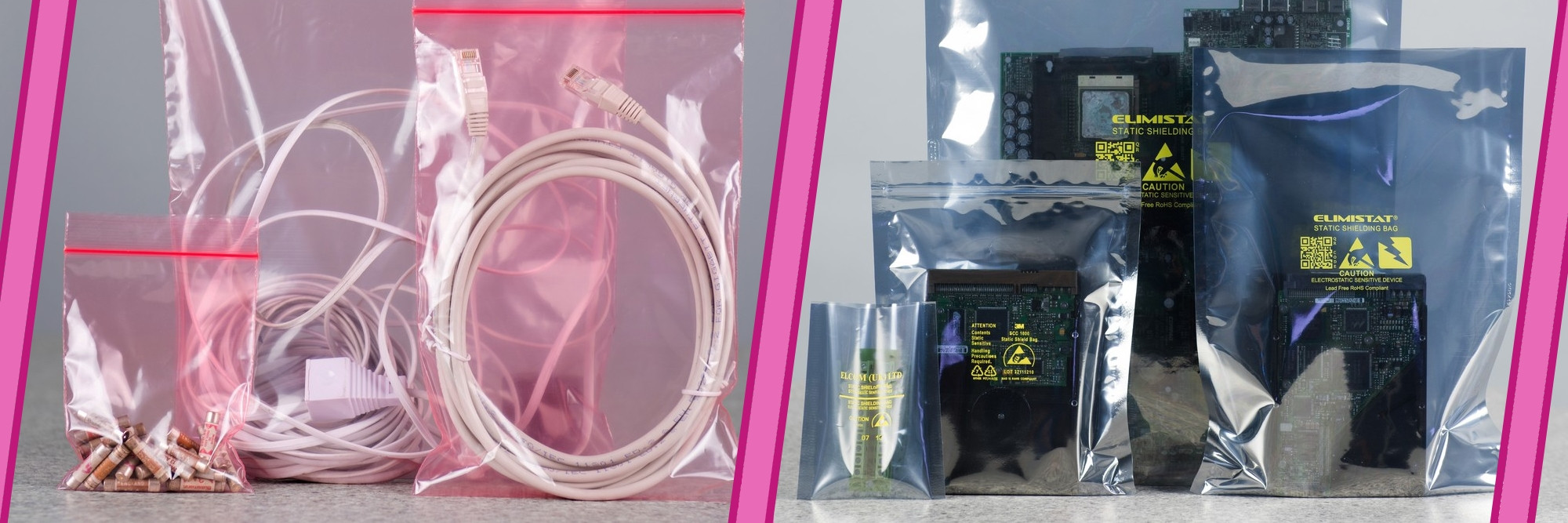
Which type of antistatic bag should I buy?
Your choice of antistatic bag will depend largely on what items you are handling with that antistatic bag. Both types of bag are classed as static-dissipative, but the ESD bags offer greater protection to the contents of the bag than the pink antistatic bags.
As a simple rule of thumb, if the item being handled is static-sensitive or has static-sensitive components and is being handled outside of an electrostatic protected area (EPA, see below), then you should use a static shield bag to protect the contents of the bag from a potential electrostatic discharge (ESD).
Static-sensitive items include: microchips, printed circuit boards (PCBs), motherboards, graphics cards, oscillators, microelectromechanical Systems (MEMS).
If you are handling items that are not static-sensitive themselves but may come into contact with static-sensitive items, then you can use pink antistatic bags.
This allows you to package, transport and handle things like tools, safety equipment, spare parts, instruction booklets and anything else that could potentially discharge onto a static-sensitive product in the manufacturing process.
Different types of antistatic bags will often be used together, or alongside other layers of antistatic packaging - such as pink antistatic bubble bags or layflat tubing - to provide protection from both electrostatic and physical damage.
Please note: Whatever type of antistatic bag you buy, you should always take care to monitor the condition of the bag, as this will deteriorate over time and will become less effective at protecting against static electricity.
All antistatic packaging should be opened in an electrostatic or ESD protected area (EPA) or a static-free workstation.
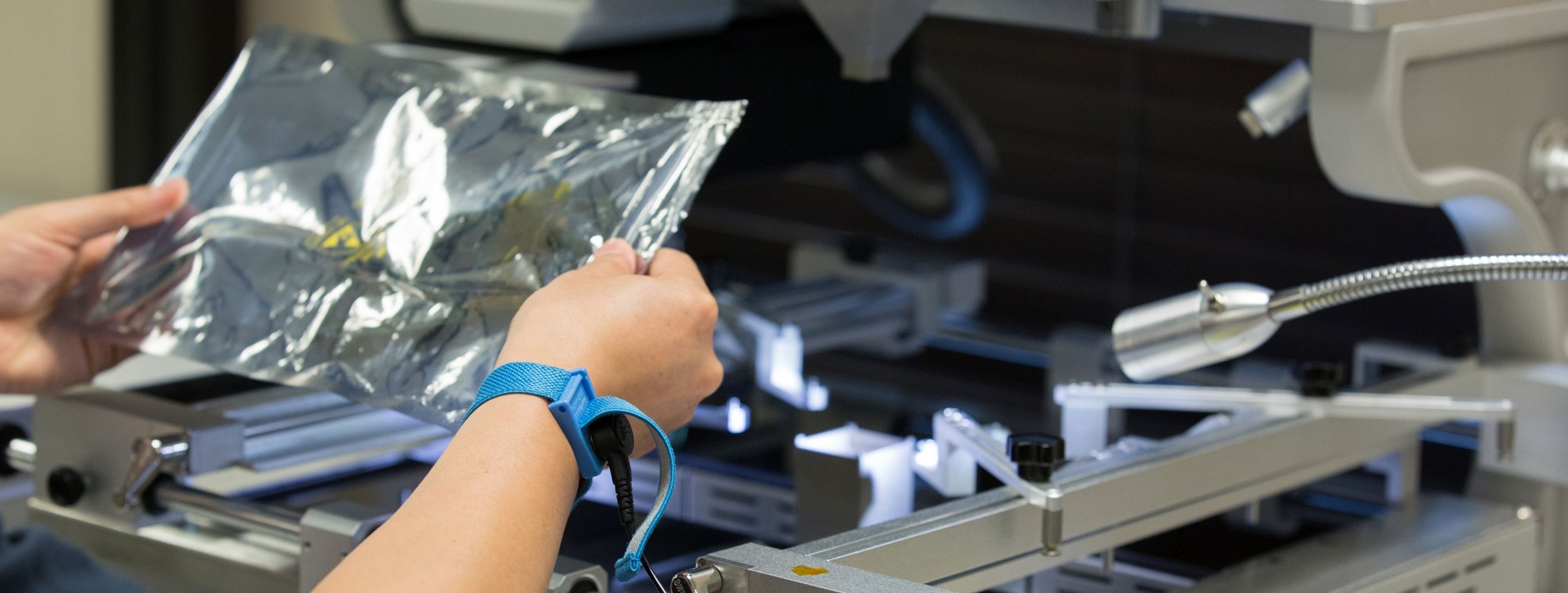
Electrostatic protected area (EPA)
An electrostatic protected area, or ESD protected area (EPA) is a workspace where all objects within the area, including the person working, are kept at the same electrical potential.
An effective EPA is very important for the manufacture, servicing or repair of electronic items, to minimise the risk of damage to sensitive electronic components from electrostatic discharge (ESD).
An EPA can be a single workstation or a combination of multiple workstations. To maintain a consistent electrical potential throughout the EPA, all insulators should be removed and all conductors - including people - should be grounded.
All items and operators at the workstation should be electrically bonded together and connected to the ground, or a suitable common grounding point. To this end, operators must wear a wrist strap, which is attached to a grounding cord that connects to the static dissipative work surface, which in turn connects to a common grounding point.

Glossary
Antistatic - Something that prevents the build-up of electrostatic charge (static electricity) or reduces its effects.
Conductor - A substance (e.g. copper, steel) that allows an electrical charge to pass easily through it.
Dissipative antistatic bag - Distincitve pink bag made from antistatic polythene that, when it comes into contact with an electrical charge, dissipates (spreads) that charge across its surface to ground.
Electrostatic discharge - An electric shock; the sudden flow of electricity between two objects.
Electrostatic discharge bag - Silver multi-layered polythene bag with an antistatic outer and inner layer surrounding a conductive central layer. The outer and inner layer prevent tribocharging whilst the central layer protects the bag's contents from a potential electrostatic discharge from an exteral source.
Electrostatic protected area - A workstation or area where all surfaces, people and objects are kept at the same electrical potential. An important feature in the manufacture, servicing or repair of electronics to protect sensitive equipment from the damaging effects of static electricity.
EPA - Electrostatic protected area (see above).
ESD - Electrostatic discharge (see above).
ESD bags - Electrostatic discharge bags (see above).
Faraday cage - A covering or 'cage' of conductive material that, when it comes into contact with an electrical charge, distributes the charge around the cage, thereby protecting its contents.
Insulator - A substance (e.g. plastic, rubber) that offers a high resistance to eletric current, preventing it from passing through it.
Static-dissipative - Dissipative antistatic bag (see above).
Static electricity - The result of an imbalance between positive (proton) and negative (electron) electrical charges in an object. These charges can build up on the surface of an object until they find a way to move via an electrical current or discharge.
Static shield bag - Electrostatic discharge bag (see above).
Surface resistivity - The measure of how well a material opposes the flow of electric current. The higher a material's surface resistivity, the greater its resistance to electrical charge. Insulators (e.g. plastics) have a higher surface resistivity than conductors (e.g. metals).
Tribocharging - Derived from the Greek word 'tribein', meaning 'to rub', triboelectric charging (or triborcharging for short) is the build-up of static electricity that occurs when two objects come into contact with each other leading to unequal charges on the two items (one positively charged, one negatively charged).
FREE DELIVERY

230mm wide x 318mm length, 55 micron thickness. (Large Letter A4).
From £17.59 per 200
Bio and 100%-recycled mailing bags in low quantity handypacks.


